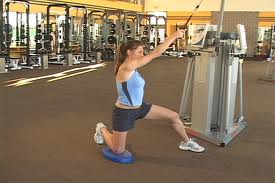That’s a half truth. They may not necessarily make you fat, but they definitely aren’t helping you get a flatter stomach.
Top 3 reasons why you’re wasting your time performing crunches
1) Beach Ball Belly Syndrome:
If you still have some stubborn body fat to lose, those crunches are just making your belly stick out even farther. The abdominal muscles are actually located beneath a layer of subcutaneous fat. So when you perform crunches, you’re actually increasing the size of your abdominals which in turn increases the circumference of your stomach by pushing out against that layer of subcutaneous fat. There is no such thing as spot reduction, no matter how much the advertisers try to convince you there is. Check out this brand new clinical study completely dispelling spot reduction for the stomach: http://www.ncbi.nlm.nih.gov/pubmed/21804427
Researchers’ conclusion: “Six weeks of abdominal exercise training alone was not sufficient to reduce abdominal subcutaneous fat and other measures of body composition.”
2) Low Back Pain
Dr. Stuart McGill, one of the leading researchers in the world of low back pain, firmly believes (as well as has quite a bit of evidence) that crunches will eventually lead to low back. According to Dr. McGill, through his years of research and treatment, the lumbar spine has only so many flexion cycles per lifetime. Once we reach our flexion threshold, we experience low back pain. At his lab, he actually creates low back pain in pig spines by constantly flexing the spine, similar to crunches, until the spine eventually breaks down. From a functional anatomy perspective, it makes sense. In daily living, the abdominals do not create movement (a.k.a. crunches). They actually resist movement and provide stability. They act as a stable core so force can be transmitted from the legs to the arms and vice versa. Thus, we weren’t meant to constantly crunch. That’s why planks, side planks, and cable chops have become so popular in the women’s fitness magazines.
3) Bad Posture
Dr. Vladamir Janda, who many consider the father of modern physical therapy, termed a condition called upper cross syndrome. Basically, it’s when the pectorals become tight and contracted while the middle back muscles become lengthened and weakened pulling the shoulders forward. Eventually this leads to neck pain, shoulder pain, and even back pain. Unfortunately in today’s society, it is a lot more prevalent than it has been in the past. Why? We sit at desks all day staring at computer screens with shoulders hunched over in a slouched position. Add hundreds of crunches to sitting at a desk all day, and we’ve basically compounded the problem. Essentially a crunch is the exact same position as you sitting at your desk. Your shoulders are hunched forward and your lower back is rounded. Not good.
What do to?
If you still have a few pounds to drop, don’t waste your time with abdominal work. Instead try high intensity interval training (HIIT). It’s better than steady state cardio on the treadmill or elliptical. Basically, you exercise intensely for 20-30 seconds and then you rest for 30-60 seconds. You repeat that cycle between 10-15 times. You can perform it on a treadmill, elliptical, bike, our battling ropes, with a kettlebell, or almost any other training tool you can think of. Even a jump rope works great. You’re only limited by your imagination. Not only is it quicker (15-20 minutes and you’re done), but it also burns more fat. Check this out:
Researchers compared 20 weeks of steady state endurance training and 15 weeks of interval training with regards to fatloss. Even though the endurance training group (cardio bunnies) burned 15,000 more calories overall, the interval group showed 9 TIMES greater loss in subcutaneous fat. (Tremblat, at al. Metabolism. 1994).
Approved Abdominal Exercises
Once you’ve reached your bodyweight goal, you can start performing abdominal training again. Stick to these 4 categories:
- Anti-extension: Planks, stability ball rollouts, ab wheel
- Anti-Flexion: Side planks and their variations
- Anti-rotation: Pallof Press and its variations
- Rotary Training: Chops, Lifts, Around the World





Speak Your Mind